27 November 2010 (Shibi'i)
Day #256, 5934 AM
The Jewish Christmas
Exposing the Mithraic Lie of Hanukkah
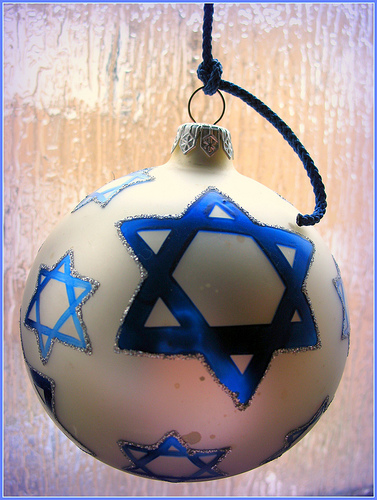
In a few day's time millions of Jews and thousands of Messianic Jews (plus a few Messianic Israelites) will be celebrating the Jewish Festival of Lights better known as Chanukah or Hanukkah. In the same way that Christmas poses as a Christian festival when in fact it is semi-Christianised version of an ancient European pagan winter solstice festival known as Yule and Saturnalia, so Hanukkah is, in fact, a variation of the same ancient pagan winter solstice festival but from even more ancient roots in Asia where it is known as Deepawali (the ancient Hindu Festival of Lights) and Chaharshanbe Suri, the ancient Persian Zoroastrian New Year, whose deity was Mithra, the god of light (or sun-god).
When in 1999 I became convinced by Scripture and the Ruach haQodesh (Holy Spirit) to become Torah-observant, I at first assumed that Messianics, who for the most part have simply continued Jewish traditions, were observing Torah in biblical purity. It took several years for me to sift through the known historical records to discover that the majority of Messianics were in some cases as deeply paganised as the orthodox Christians (Catholics, Eastern Orthodox and Protestant) whom they sought to stigmatise and accuse of apostacy. One of the most blatantly neo-pagan festivals of the of the Jewish calendar is without doubt Hanukkah - it is literally the 'Jewish Christmas'. Hanukkah and Christmas are close spiritual and historical cousins as we shall see, and for former orthodox Christians converting to Messianism, the changeover from Christmas to Hanukkah is accomplished with relative ease, since both have the same temporal and spiritual pedigree.
"Then Moses called Joshua and said to him in the sight of all Israel, 'Be strong and of good courage, for you must go with this people to the land which Yahweh has sworn to their fathers to give them, and you shall cause them to inherit it. And Yahweh, He is the one who goes before you. He will be with you, He will not leave you nor forsake you; do not fear nor be dismayed.' So Moses wrote this Torah (Law) and delivered it to the cohenim (priests), the sons of Levi, who bore the ark of the covenant of Yahweh, and to all the elders of Israel. And Moses commanded them, saying: 'At the end of every seven years, at the appointed time in the year of release, at Sukkot (the Feast of Tabernacles), when all Israel comes to appear before Yahweh your Elohim in the place which He chooses, you shall read this Torah (Law) before all Israel in their hearing. Gather the people together, men and women and little ones, and the stranger who is within your gates, that they may hear and that they may learn to fear Yahweh your Elohim and carefully observe all the words of this Torah (Law), and that their children, who have not known it, may hear and learn to fear Yahweh your Elohim as long as you live in the land which you cross the Jordan to possess'" (Deut.31:7-13, NKJV).
The Torah was to be read at the last annual moed or appointment, Sukkot. Between the end of this festival - on the 21st of Tishri or Shibi'i haChodesh, the Seventh Month (around September/October) - and the beginning of the New Year - on the 1st of Aviv or Rishon haChodesh, the First Month (around March/April) - a period of about 5 months - there were to be no festivals apart from the monthly Rosh Chodesh or New Moon observances and weekly 7th day Shabbats. Unlike in pagan religions were these are very prominent indeed, Yahweh commanded no mid-summer or mid-winter festivals.
And yet in Judaism and its Messianic offshoots we find two festivals being observed during the winter months, one around the winter solstice at Hanukkah and another called Purim commanded by a Benjamite Queen of Persia, Esther without any kind of authority, however heroic her deeds on behalf of Judah. For:
"Yahweh is our Judge, Yahweh is our Lawgiver (Torah-giver), Yahweh is our King" (Isa.33:22, NKJV).
As I have pointed out in various articles and sermons over the years, Yahweh nowhere commands in Scripture that we are to observe Hanukkah, use light 9-armed Hanukkah candlearbres, or recite obligatory prayers as the Rabbis claim and which Messianics have uncritically copied them. Neither did any miracle of the oil ever take place - it was a Pharisee fabrication, along with the Books of the Maccabees, to bolster their claims for authority. Hanukkah is surrounded by fables and myths that have more in common with paganism than with any revelation of the Most High. Like attracts like, it would seem, for over the years Hanukkah has come to resemble Christmas more and more with the addition of Hanukkah Bushes (cp. Christmas Trees), Hanukkah Harry (cp. Santa Claus/Father Christmas) and present-giving.
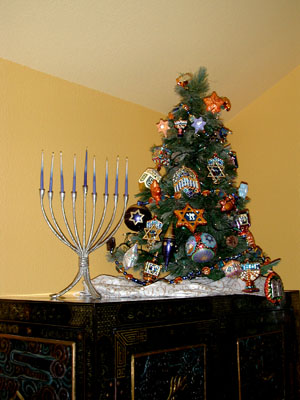 The Jewish Christmas Tree or 'Hanukkah Bush'
The Jewish Christmas Tree or 'Hanukkah Bush'
Yahweh hates pagan practices and has forbidden additions to His festivals:
"Now, O Israel, listen to the statutes and the judgments which I teach you to observe, that you may live, and go in and possess the land which Yahweh-Elohim of your fathers is giving you. You shall not add to the word which I command you, nor take anything from it, that you may keep the commandments of Yahweh your Elohim which I command you" (Deut.4:1-2, NKJV).
We have been given the weekly sabbath, the monthly Rosh Chodesh, the seven annual festivals, the Sabbatical Year every 7 years, and the Jubilee Year every 50 years and that is all - no Hanukkah, no Purim, no Rosh haShanah, no Christmas, no Easter, no Halloween, no New Year's Day, and any of the dozens of other festivals that Christians and Messianics have added in breach of the commandments of the Most High. All religious festivals outside the Torah are from the enemy, no matter how 'spiritual' or 'good' they may look, and those who observe them are walking in disobedience and rebellion.
Now it is perfectly true that Purim is named in the Book of Esther. However, the Book of Esther was never in the original Old Testament canon, as the Dead Sea Scrolls have shown, and the version we have today has been mutilated so we don't know what is fact and what is fiction - see False Paradigms for more information. It is also perfectly true that Hanukkah is mentioned in the New Testament but Yah'shua (Jesus) never endorsed it, as is falsely claimed by many Messianics - see Our Last Hanukkah: The Gospel vs. The Sword. Indeed all the New Testament says is:
"Now it was the Feast of Dedication (Feast of Lights, Hanukkah) in Jerusalem, and it was winter. And Yah'shua (Jesus) walked in the temple, in Solomon's porch" (John 10:22-23, NKJV).
From this solitary verse, most Messianics conclude that Yah'shua observed Hanukkah. But if you read what follows carefully, Yah'shua was not at the Temple to celebrate the Feast of Dedication but to rebuke those who refused to believe in Him (vv.24-40). In the same way, if I went into a Church on Christmas day and started calling people to repent of their sins, it would not prove that I observed Christmas, merely that I happened to be calling people to repentance on Christmas Day in a building where disobedient believers were observing Christmas. That is all that John 10:22 says and we should not read into it things which are not there. Faced with such a passage of scripture, the honest student will examine the subject thoroughly, what Torah says about Yahweh's festivals and what we know of the history of Hanukkah. Dig around enough and you'll discover more or less what I am sharing with you today.
We are to be extremely careful to ensure that our religious practices do not borrow from paganism in any way:
"When Yahweh your Elohim cuts off from before you the nations which you go to dispossess, and you displace them and dwell in their land, take heed to yourself that you are not ensnared to follow them, after they are destroyed from before you, and that you do not inquire after their gods, saying, 'How did these nations serve their gods? I also will do likewise.' You shall not worship Yahweh your Elohim in that way; for every abomination to Yahweh which He hates they have done to their gods; for they burn even their sons and daughters in the fire to their gods. Whatever I command you, be careful to observe it; you shall not add to it nor take away from it" (Deut.12:29-32, NKJV).
The Bible warns again and again against religious syncretism - worshipping the True Elohim (God) using pagan forms. This does not just involve the more obvious abominations like Molech worship (such as our world leaders and industrialists do annually at the Bohemian Grove) but anything that is tainted with paganism. Hence the injunction to "be careful" - to take great care! For Yahweh will only accept the worship which He has ordained. And while He is merciful in the days of our ignorance, showing much grace and forebearance, once we know what is of Him and what is not (through careful study of the Scriptures), we can no longer make excuses and expect His grace to continue indefinitely. We are not to follow our deceitful hearts but His Word.
For one thing, willful disobedience gives the enemy legal grounds to oppress us, which no believer in his or her right mind would want, would they? Recall, also, that under the Old Covenant the sacrifices only covered sins of ignorance (Lev.5:18). So once you know the truth, you are responsible to take action, and the excuse-making days of ignorance are over. To shun the truth is to play with fire and to gamble with your salvation. For another thing, willful disobedience breaks covenant and relationship with the Creator which is accompanied by a withdrawl of the Ruach haQodesh (Holy Spirit). Does any believer want that?
I belabour these points because Hanukkah is governed by very powerful demons. Those who stand against Hanukkah provoke all kinds of irrational behaviours, hostile and malevolent, in much the same way as Christmas, though arguably (from my experience) worse. Hanukkah is first and foremost a military holiday and closely linked to it is bloodshed and (like Purim) revenge. Strong, prideful and aggressive nationalistic spirits attach themselves to it. And the way some people react to any criticism of it, you would think Hanukkah was the Holy of Holies when it comes to Jewish observances, more important than any of the other festivals. It's an integral part of Jewish culture, and as those of you who know anything about 'culture', this is is what you do when you have forgotten why you are doing it. And Hanukkah has a lot of hidden spirits behind the 'doings'.
Again, I repeat: if it isn't in Leviticus 23, you shouldn't be observing it. Isn't it interesting how those who end up rejecting Yahweh often rush back to all these pagan customs? Nature abhors a vacuum - we were made by Yahweh to worship Him in a certain way and when we reject Him demons take over and move us to worship their way, even if we claim to be atheist. Man will always worship something and follow rituals even if they are of his own private invention, but usually they will follow like sheep what the masses are doing.
The original Hanukkah was no more than a late Sukkot for those who had been unable to observe the latter because of the oppression at that time. In that respect it was a bit like celebrating a late Passover for those who were unable to attend the main one, as authorised by Scripture (Num.9:6-13). This Pesach Sheini or 'Second Passover' could be observed on the 14th day of the Second Month (Iyar). All the accoutrements of modern Hanukkah were added much later, including the preoccupation with lighting candles and lamps. These later embellishments of this 'late Sukkot' caused the festival to acquire a name of its own, including - and especially - the Festival of Lights.
In the country I grew up in - Malaysia - another 'Festival of Lights was observed by the large Hindu community, and was know among them (as it still is today) as Deepavali, Diwali or Divali. This is the most important holiday of the year for Hindus and is widespead in India, Nepal, Sri Lanka, Myanmar (Burma), Indonesia, Mauritius, Guyana, Trinidad & Tobago, Suriname, Malaysia, Singapore, and Fiji. And it is one of the oldest surviving pagan religions in the world that is not far removed from the pagan practices of old described in the Bible. I remember as a boy attending this festival once and being shocked by the knives, swords, pins and other sharp objects used to pierce the flesh of highly drugged-up devotees. I recall seeing the Hindu 'holy men' walking over a pit filled with red-hot coals unharmed and the many lights. We had many Indian friends so it was not uncommon for us to attend Hindu religious gatherings, festivals, birthday parties and weddings.
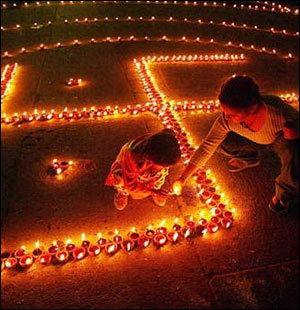 The Hindu Festival of Dewali
The Hindu Festival of Dewali
Something that I have found interesting when listening to Christians and Messianics justify their continuing observance of the pagan elements of Christmas and Hanukkah, respectively, in the face of the historical truths about these festivals, is the use of allegory. Since Christ is 'light', they have little problem linking Him to anything ritualistic that has to with lights. Speaking of Deepavali use of lights, we read:
"While Deepavali is popularly known as the “festival of lights”, the most significant spiritual meaning is “the awareness of the inner light”. Central to Hindu philosophy is the assertion that there is something beyond the physical body and mind which is pure, infinite, and eternal, called the Atman. The celebration of Deepavali as the “victory of good over evil”, refers to the light of higher knowledge dispelling all ignorance, the ignorance that masks one’s true nature, not as the body, but as the unchanging, infinite, immanent and transcendent reality. With this awakening comes compassion and the awareness of the oneness of all things (higher knowledge). This brings Ananda (joy or peace). Just as we celebrate the birth of our physical being, Deepavali is the celebration of this Inner Light" (Wikipedia, Diwali).
You will find this gnostic element lying behind all Light Festivals such as these. Salvation, in all pagan religion, is associated with the acquisition of knowledge as symbolised by light. This celebration of light then, effectively, becomes a celebration of the Tree of the Knowledge of Good and Evil - salvation by experimentation, the search for an inner light of truth (the 'Christ-self in New Age Christian teaching) and therefore salvation-from-within.
The same idea is to be found in all pagan winter solstice religion. Chaharshanbe Suri, the ancient pre-Islam Persian New Year Festival which goes back nearly 4,000 years to the Zoroastrian era, was marked by the lighting of bonfires over which singing revellers jumped to symbolise spiritual purification from illness and personal problems. This is still observed by modern Iranians (most of whom are Shia Muslims) though without the Zoroastrian elements.
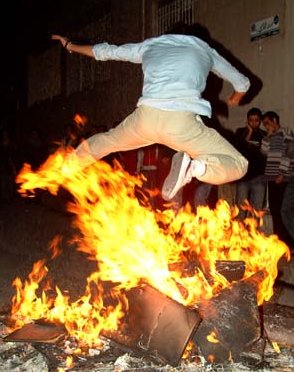 Persian Chaharshanbe Suri
Persian Chaharshanbe Suri
"Ancient Iranians celebrated the last 5 days of the year in their annual obligation feast of all souls, Hamaspathmaedaya (Farvardigan or popularly, Forodigan). They believed Faravahar, the guardian angels for humans and also the spirits of dead would come back for reunion. There are the seven Amesha Spenta, that are represented as Haftseen or literally the seven S. These spirits were entertained as honored guests in their old homes, and were bidden a formal ritual farewell at the dawn of the New Year. The festival also coincided with festivals celebrating the creation of fire and humans. In Sassanid period the festival was divided into two distinct pentads, known as the lesser and the greater Pentad, or Panji as it is called today. Gradually the belief developed that the ‘Lesser Panji’ belonged to the souls of children and those who died without sin, whereas ‘Greater Panji’ was truly for all souls.
"From Persia we get Mithra, the Persian god of light and sacred contracts. Mithraism is also known as Nicolaitans spoken of in the message to the churches of Revelation. These churches are the Seven Lamp Stands, not Chanukiahs (Hanukkah menorah with two extra arms).
"Mithra was an embodiment of the sun, so this period of its rebirth was a major day in Mithraism, which had become Rome’s latest official religion with the patronage of Aurelian. It is believed that the emperor Constantine adhered to Mithraism up to the time of his conversion to Christianity. He was probably instrumental in seeing that the major feast of his old religion was carried over to his new faith” (Gerard and Patricia Del Re, The Christmas Almanac, 1979, p. 17).
The Nicolaitan Error is detailed in Scripture thus:
"To the angel (messanger) of the assembly of Ephesus write, 'These things says He who holds the seven stars in His right hand, who walks in the midst of the seven golden lampstands: 'I know your works, your labour, your patience, and that you cannot bear those who are evil. And you have tested those who say they are apostles and are not, and have found them liars; and you have persevered and have patience, and have laboured for My name's sake and have not become weary. Nevertheless I have this against you, that you have left your first love (Yah'shua/Jesus). Remember therefore from where you have fallen; repent and do the first works, or else I will come to you quickly and remove your lampstand from its place -- unless you repent. But this you have, that you hate the deeds of the Nicolaitans, which I also hate. He who has an ear, let him hear what the Ruach (Spirit) says to the assemblies. To him who overcomes I will give to eat from the tree of life, which is in the midst of the Paradise of Elohim (God)''" (Rev 2:1-7, NKJV).
I want you to notice several things here. Firstly, false apostles introduced the Nicolaitan error. Secondly, there is an association implied with lampstands or authentic seven-armed menorahs which here symbolise the Light of Emet or Truth (Yah'shua the Messiah/Jesus Christ) shining out of authentic messianic congregations or churches. But what was the sin of the Nicolaitans which Yahweh hated so much?
"But I have a few things against you, because you have there those who hold the doctrine of Balaam, who taught Balak to put a stumbling block before the children of Israel, to eat things sacrificed to idols, and to commit sexual immorality. Thus you also have those who hold the doctrine of the Nicolaitans, which thing I hate" (Rev.2:14-15, NKJV).
Nicolas of Antoich gave his name to a group of early believers in Antioch (Ac.6:5) who sought to work out a compromise with paganism so that Christians could take part without embarrassment on some of the social and religious activities of the close-knit society in which they found themselves. Many also believe that the term 'Nicolaitan' is a Hellenised form of the Hebrew Balaam, and therefore allegorical, the policy of the sect being likened to that of an Old Testament corruptor of Israel (Num.22). I suspect that both propositions are true, that the Nicolaitans not only advocated for religious and social compromises with paganism but also sought to imitate the lax pagan sexual behaviour of the day too, in which case these are the people attacked by Peter (2 Pet.2:15), Jude (11), and John (Rev.2:14,20-23). That these people had gnostic leanings and were involved with a Gnostic sect that flourished as far as A.D.200 is proven by references made by Irenaeus, Clement and Tertullian.
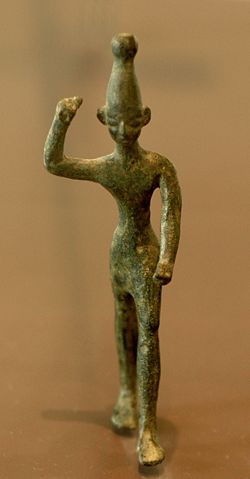 The pagan god Baal
The pagan god Baal
The pagan, Gnostic element is then pretty well established in a form of religious syncretism. The new Christian faith was already absorbing pagan elements in order to make life easier for believers in a pagan culture. Doesn't that sound familiar when it comes to the practice of Christmas and Hanukkah today by contemporary Christians and Messianics?
"For that day [25th of December] was sacred, not only to the pagan Romans but to a religion from Persia which, in those days, was one of Christianity’s strongest rivals. This Persian religion was Mithraism, whose followers worshipped the sun, and celebrated its return to strength on that day. The church finally succeeded in taking the merriment, the greenery, the lights, and gifts from Saturn and giving them to the Babe of Bethlehem" (Earl W. Count, 4000 Years of Christmas, p.27).
The Christian tradition of light during the Christmas season is demonstrated by the Advent Candles which are lit each of four consecutive Sundays before Christmas Day. Additionally some families burn a yule log. This tradition goes back pre-Christian celebrations during Winter Solstice, as we know. Egyptian Christmas is celebrated on January 6th and 7th. The churches have always been decorated with special lamps and candles. Egyptian Copts also give candles to the poor. They represent the candles Joseph used to supposedly protect Mary with when Yah'shua (Jesus) was born. On the night of the 6th, the Coptic Christians go to the church for mass and at midnight they eat dinner On the morning of the 7th gifts are exchanged and people visit each other. There are four weeks of Advent during which a candle is lit each week. In Egypt, Advent lasts for forty-five days and people fast. They do not eat any meat, poultry or dairy products. Everyone buys new clothes to wear to the Christmas Eve church service. Before Christmas, Christian homes are decorated with lights, Christmas trees and small mangers. On Christmas morning people visit friends and neighbours. They bring a gift of shortbread which is called Kaik.
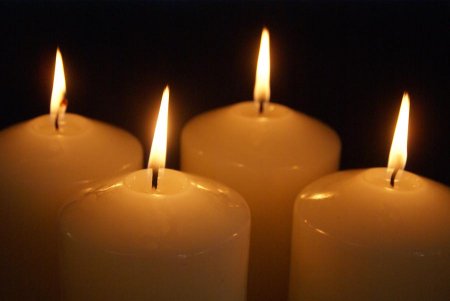
Christians in China celebrate Christmas by lighting their houses with paper lanterns. They also have Christmas trees called 'Trees of Light', with paper chains, flowers, and lanterns. Chinese children hang muslin stockings and await a visit from Santa Claus, whom they call Dun Che Lao Ren (dwyn-chuh-lau-oh-run) which means 'Christmas Old Man'. Most Chinese people are not Christian so the main winter festival in China is the Chinese New Year which takes place toward the end of January. This is when children receive new clothing, eat fancy meals, get new toys, and enjoy fireworks.
"Another peculiarity of the Papal worship is the use of lamps and wax-candles. If the Madonna and child are set up in a niche, they must have a lamp to burn before them; if mass is to be celebrated, though in broad daylight, there must be wax-candles lighted on the altar; if a grand procession is to be formed, it cannot be thorough and complete without lighted tapers to grace the goodly show. The use of these lamps and tapers comes from the same source as all the rest of the Papal superstition. That which caused the “Heart,” when it became an emblem of the incarnate Son, to be represented as a heart on fire, required also that burning lamps and lighted candles should form part of the worship of that Son; for so, according to the established rites of Zoroaster, was the sun-god worshipped.
"When every Egyptian on the same night was required to light a lamp before his house in the open air, this was an act of homage to the sun, that had veiled its glory by enshrouding itself in a human form. When the Yezidis of Koordistan, at this day, once a year celebrate their festival of “burning lamps,” that, too, is to the honour of Sheikh Shems, or the Sun. Now, what on these high occasions was done on a grand scale was also done on a smaller scale, in the individual acts of worship to their god, by the lighting of lamps and tapers before the favourite divinity.
"In Babylon, this practice had been exceedingly prevalent, as we learn from the Apocryphal writer of the Book of Baruch. “They (the Babylonians),” says he, “light up lamps to their gods, and that in greater numbers, too, than they do for themselves, although the gods cannot see one of them, and are senseless as the beams of their houses.”
"In Pagan Rome, the same practice was observed. Thus we find Licinius, the Pagan Emperor, before joining battle with Constantine, his rival, calling a council of his friends in a thick wood, and there offering sacrifices to his gods, “lighting up wax-tapers” before them, and at the same time, in his speech, giving his gods a hint, that if they did not give him the victory against Constantine, his enemy and theirs, he would be under the necessity of abandoning their worship, and lighting up no more “wax-tapers to their honour.” In the Pagan processions, also, at Rome, the wax-candles largely figured. “At these solemnities,” says Dr. Middleton, referring to Apuleius as his authority, “at these solemnities, the chief magistrate used frequently to assist, in robes of ceremony, attended by the priests in surplices, with wax-candles in their hands, carrying upon a pageant or thensa, the images of their gods, dressed out in their best clothes; these were usually followed by the principal youth of the place, in white linen vestments or surplices, singing hymns in honour of the gods whose festivals they were celebrating, accompanied by crowds of all sorts that were initiated in the same religion, all with flambeaux or wax-candles in their hands.” Now, so thoroughly and exclusively Pagan was this custom of lighting up lamps and candles in daylight, that we find Christian writers, such as Lactantius, in the fourth century, exposing the absurdity of the practice, and deriding the Romans “for lighting up candles to God, as if He lived in the dark.” Had such a custom at that time gained the least footing among Christians, Lactantius could never have ridiculed it as he does, as a practice peculiar to Paganism. But what was unknown to the Christian Church in the beginning of the fourth century, soon thereafter began to creep in, and now forms one of the most marked peculiarities of that community that boasts that it is the “Mother and mistress of all Churches.”
"While Rome uses both lamps and wax-candles in her sacred rites, it is evident, however, that she attributes some pre-eminent virtue to the latter above all other lights. Up to the time of the Council of Trent, she thus prayed on Easter Eve, at the blessing of the Easter candles: “Calling upon thee in thy works, this holy Eve of Easter, we offer most humbly unto thy Majesty this sacrifice; namely, a fire not defiled with the fat of flesh, nor polluted with unholy oil or ointment, nor attained with any profane fire; but we offer unto thee with obedience, proceeding from perfect devotion, a fire of wrought WAX and wick, kindled and made to burn in honour of thy name. This so great a MYSTERY therefore, and the marvellous sacrament of this holy eve, must needs be extolled with due and deserved praises.”
"That there was some occult “Mystery,” as is here declared, couched under the “wax-candles,” in the original system of idolatry, from which Rome derived its ritual, may be well believed, when it is observed with what unanimity nations the most remote have agreed to use wax-candles in their sacred rites. Among the Tungusians, near the Lake Baikal in Siberia, “wax-tapers are placed before the Burchans,” the gods or idols of that country. In the Molucca Islands, wax-tapers are used in the worship of Nito, or Devil, whom these islanders adore. “Twenty or thirty persons having assembled,” says Hurd, “they summon the Nito, by beating a small consecrated drum, whilst two or more of the company light up wax-tapers, and pronounce several mysterious words, which they consider as able to conjure him up.”
"In the worship of Ceylon, the use of wax-candles is an indispensable requisite. “In Ceylon,” says the same author, “some devotees, who are not priests, erect chapels for themselves, but in each of them they are obliged to have an image of Buddha, and light up tapers or wax-candles before it, and adorn it with flowers.” A practice thus so general must have come from some primeval source, and must have originally had some mystic reason at the bottom of it. The wax-candle was, in fact, a hieroglyphic, like so many other things which we have already seen, and was intended to exhibit the Babylonian god in one of the essential characters of the Great Mediator. The classic reader may remember that one of the gods of primeval antiquity was called Ouranos*, that is, “The Enlightener.”
*For Aor or our, “light,” and an, “to act upon” or produce, the same as our English particle en, “to make.” Ouranos, then, is “The Enlightener.” This Ouranos is, by Sanchuniathon, the Phoenician, called the son of Elioun–i.e., as he himself, or Philo-Byblius, interprets the name, “The Most High.” (SANCH) Ouranos, in the physical sense, is “The Shiner”; and by Hesychius it is made equivalent to Kronos, which also has the same meaning, for Krn, the verb from which it comes, signifies either “to put forth horns,” or “to send forth rays of light”; and, therefore, while the epithet Kronos, or “The Horned One,” had primarily reference to the physical power of Nimrod as a “mighty” king; when that king was deified, and made “Lord of Heaven,” that name, Kronos, was still applied to him in his new character as “The Shiner or Lightgiver.” The distinction made by Hesiod between Ouranos and Kronos, is no argument against the real substantial identity of these divinities originally as Pagan divinities; for Herodotus states that Hesiod had a hand in “inventing a theogony” for the Greeks, which implies that some at least of the details of that theogony must have come from his own fancy; and, on examination, it will be found, when the veil of allegory is removed, that Hesiod’s “Ouranos,” though introduced as one of the Pagan gods, was really at bottom the “God of Heaven,” the living and true God.
"In this very character was Nimrod worshipped when he was deified. As the Sun-god he was regarded not only as the illuminator of the material world, but as the enlightener of the souls of men, for he was recognised as the revealer of “goodness and truth.” It is evident, from the Old Testament, not less than the New, that the proper and personal name of our Lord Jesus Christ is, “The Word of God,” as the Revealer of the heart and counsels of the Godhead. Now, to identify the Sun-god with the Great Revealer of the Godhead, while under the name of Mithra, he was exhibited in sculpture as a Lion; that Lion had a Bee represented between his lips. The bee between the lips of the sun-god was intended to point him out as “the Word”; for Dabar, the expression which signifies in Chaldee a “Bee,” signifies also a “Word”; and the position of that bee in the mouth leaves no doubt as to the idea intended to be conveyed. It was intended to impress the belief that Mithra (who, says Plutarch, was worshipped as Mesites, “The Mediator”), in his character as Ouranos" (Alexander Hislop, The Two Babylons, Chapter V, Section V, Lamps and Wax-Candles).
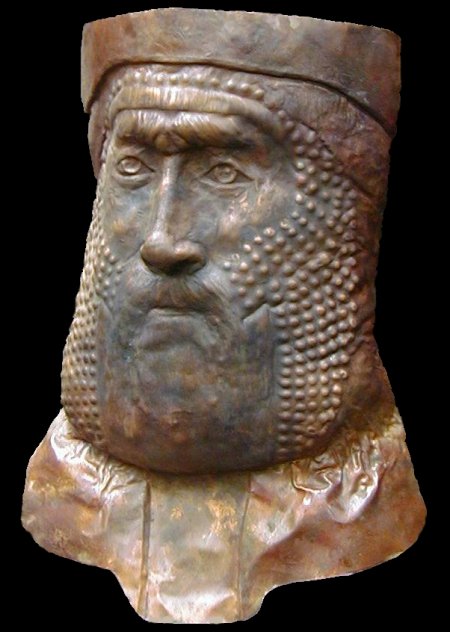 Nimrod
Nimrod
It is therefore clear that Nimrod was both Mithra and Saturn and that he was regarded as the Sun-god. When the sun is not giving very much light at the winter solstice (at Christmas and Hanukkah time), candles and fires are lit to encourage the sun to return and it works every year they do it. Judah picked up this practice while in Babylon. But it was after the Maccabees that it came to be a tradition that was sanctioned as Hanukkah. Let's now see how the Rabbis added Mithra worship both to Jewish Shabbat worship and to Hanukkah by looking at the prayers that are recited by them and by Messianics. First the Sabbath:
Barukh atah Adonai, Eloheinu, melekh ha’olam
Blessed are you, Lord, our God, sovereign of the universe
asher kidishanu b’mitz’votav v’tzivanu
Who has sanctified us with His commandments and commanded us
l’had’lik neir shel Shabbat. (Amein)
to light the lights of Shabbat. (Amen)
Yahweh has nowhere commanded is to light Sabbath candles. Nevertheless, the excuses offered by Messianics are no different from those offered by orthodox Christians for all their false pagamn traditions. And now Hanukkah:
"One candle is added to the menorah each night. The first night, you light only the shammus (the one at a different height) and one Chanukkah candle. By the eighth night, you light all of the candles.
"Candles should be added to the menorah from right to left (like Hebrew writing). The shammus candle is lit first. While holding the shammus candle, recite the following blessings. They are usually sung.
Blessing over Candles
Barukh atah Adonai, Eloheinu, melekh ha’olam
Blessed are you, Lord, our God, sovereign of the universe
asher kidishanu b’mitz’votav v’tzivanu
Who has sanctified us with His commandments and commanded us
l’had’lik neir shel Chanukah. (Amein)
to light the lights of Chanukkah. (Amen)
Blessing for Chanukkah
Barukh atah Adonai, Eloheinu, melekh ha’olam
Blessed are you, Lord, our God, sovereign of the universe
she’asah nisim la’avoteinu bayamim haheim baziman hazeh. (Amein)
Who performed miracles for our ancestors in those days at this time
Shehecheyanu (first night only)
Barukh atah Adonai, Eloheinu, melekh ha’olam
Blessed are you, Lord, our God, sovereign of the universe
shehecheyanu v’kiyimanu v’higi’anu laz’man hazeh. (Amein)
who has kept us alive, sustained us, and enabled us to reach this season (Amen)
"After reciting the blessings, use the shammus to light the Chanukkah candles from left to right (newest to oldest).
Candles should be left burning until they go out on their own. They must burn for more than half an hour. Standard Chanukkah candles burn for about an hour.
This is a lie. Not only has Yahweh never commanded us to observe Hanukkah but He has absolutely not commanded us to light 'Hanukkah lights' and there never was any miracle of the menorah oil. Not at all! This is invented man-made religion imitating the ways of the ancient pagans. Do you think Yahweh is pleased to have His Name attached to these pagan imitations and fabrications?
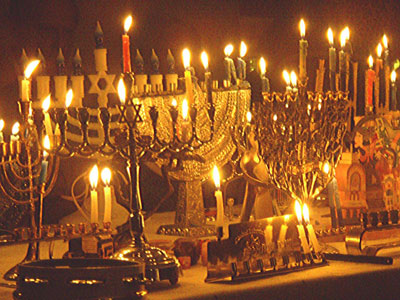 Hanukkah Lights
Hanukkah Lights
Although the Maccabees kept the Feast of Sukkot one month later because of the Syrians, no miracle of the Menorah staying lit for eight days ever happened. So if this so-called miracle is an invention of some later Rabbi, and we now know what the lighting of candles and fires for religious purposes at the winter solstice means, do you really want to add some false tradition to your walk after getting rid of so many other false teachings and lies from your former way which was not according to Torah? Do you really want to give up Christmas in order to keep Diwali or Chaharshanbe-Suri, or Hanukkah, all of which are the same thing, just wrapped up in different coloured wrapping paper? Go ahead teach your children another lie but when you do, just rememeber the condemnation that Judah brought on herself for teaching and observing these lies:
"Thus says Yahweh: 'For three transgressions of Judah, and for four, I will not turn away its punishment, because they have despised the Torah (Law) of Yahweh, and have not kept His commandments. Their lies lead them astray, lies which their fathers followed. But I will send a fire upon Judah, and it shall devour the palaces of Jerusalem" (Amos 2:4-5, NKJV).
I am being deadly serious to all you Mesasianics who insist on bringing down the same curses on yourselves as were brought upon the House of Judah for following in the ways of the heathen. Don't be fooled by all the Hebrew window-dressing. HANUKKAH IS OF THE DEVIL. Do not follow after the traditions of the Rabbis who rejected Yah'shua and Torah, inventing their own 'Oral Law'. Remember the admonition of Jeremiah:
"O Yahweh, my strength and my fortress, my refuge in the day of affliction, the Gentiles shall come to You from the ends of the earth and say, 'Surely our fathers have inherited lies, worthlessness and unprofitable things'" (Jer.16:19, NKJV).
All religious teachings not found in the Bible are worthless. The Festival of Lights which is celebrated in various ways around the world at this time of year when the sun's light gets shorter and shorter is done with candles and bonfires which are lit to give honour to Ouranos, 'The Shiner' or Light-giver', also known as Kronos, and Nimrod and the Sun. You may not know this is whom you worship, but even Satan came as an angel of light, to deceive.
Like Christmas, Hanukkah has some historical truth in it, but it is mingled with a deadly potion of Sun-god worship. Messianics who observe Hanukkah are performing no less evil than Orthodox Christians observing Christmas and have no business correcting antinomians until they first get their house in order. Both contain true historical events (the Birth of Yah'shua...though at the wrong time of the year, and the Rededication of the Temple after the Syrian persecutions) but their heart is the worship of the devil. Therefore flee both!
I know that many are deeply offended by such statements but if they will but pause to analyse their feelings they will, if they are honest, discover that their offense is not because Torah is being violated (which it absolutely is not) but cultural PRIDE:
"For all that is in the world -- the lust of the flesh, the lust of the eyes, and the pride of life -- is not of the Father but is of the world" (1 John 2:16, NKJV).
If this is a 'cultural' or 'national' gut-response, then you need to repent, for Yahweh does not honour these things. I have had to abandon many of the cultural traditions of my country Great Britain that I took pride in because I discovered they were an abomination to Yahweh. Yahweh is nor respector of persons or nations, including Judaism and the Republic of Israel. No one is, in any case, so 'special', 'chosen' or 'anointed' that Yahweh gives them licence to disobey His commandments. All pride in these things has to be laid down and nailed to the Cross in deep contrition.
'What shall we do during this winter season, then?' many ask. If Yahweh thought you needed a festival during the time of the winter solstice, He would have given one. So why this hankering after things pagan? In a week's time Rosh Chodesh or the Feast of the New Moon will be back again - observe that instead! It's commanded whereas Hannukkah is not. Observe each Shabbat with passion and delight - that's five festivals in the Roman month of December alone. Isn't that enough? Let the pagans, Jewish and non-Jewish, worship their demons but you should have no part of it. Rather warn them with articles such as this one!
May you have a peaceful Shabbat, ignore Hanukkah next week and anticipate with delight the next Rosh Chodesh. Shalom!
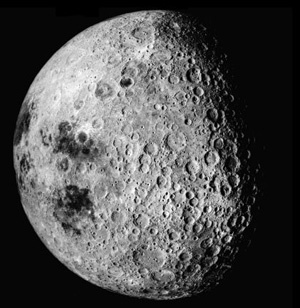
Acknowledgements
[1] Sighted Moon Newsletter 5846-041
 Share
Share
|


